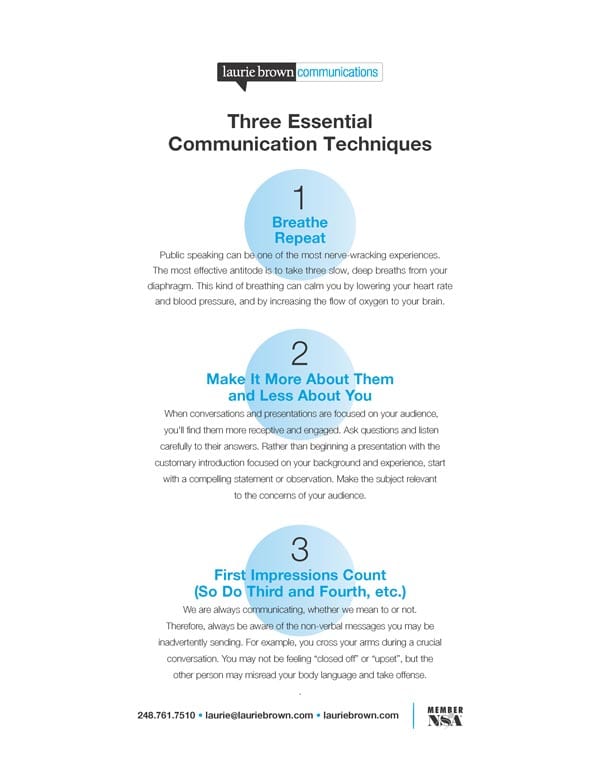-

Communication Skills Workshops
In Person & Virtual
Persuasive Communication Training
Influence and Persuade

Contact Laurie now at (248) 761-7510 for Persuasive Communication Skills Training.
This course is ideal for people who want to improve their abilities in communication and working with others, particularly suited for IT engineers, new managers, senior leadership, and salespeople.
Why do you need to improve your persuasive communication?
- Your work requires collaboration with colleagues, employees, and contractors.
- The products, services, and/or ideas you offer must be sold to others, both internally and externally.
- Whether it's personal or professional, you want to improve your relationships.
- Your goal is to keep your clients satisfied.
- It is important to be a leader who gets results.
Learning Outcomes
After successfully completing this class you will be able to do the following:
- Understand your personal communication style.
- Build relationships based on trust and respect.
- Apply the appropriate form of communication for the appropriate task.
- Demonstrate effective use of key communication techniques, including active listening and effective questioning.
- Communicate successfully up, down, and across organizations.
- Explore how to communicate with difficult people.
We will customize this program or coaching session to address your wants and needs.
Persuasive Communication Skills Topics
How Impressions are Formed. Participants will learn about the three channels of communication: body language, tone of voice, and choice of words. Through discussion and activities, participants will learn how to present themselves as credible and approachable.
Outcome: Participants will have a greater sense of how body language, tone of voice, and word selection impact how others view them.
Understanding Your Personal Communication Style. Using an assessment tool, participants will first learn about their communication style as embodied in one of four styles. Next, with the aid of a flipchart depicting their style, participants will learn about at their own preferred communication style. They will also identify the styles they find more challenging. Finally, participants will report on how their style can be identified by others.
Outcome: Participants will have better self-awareness of their style preferences and an understanding of styles different from their own.
Learning How to Build Rapport. '"Like likes like": people like people who are like them. We unconsciously communicate with others by using our own preferences rather than their likes and dislikes. In this section, participants will further explore communication styles, and through role-playing, learn techniques to help them minimize the differences between themselves and others.
Outcome: Participants will know how to build rapport with people with styles dissimilar to theirs
Active and Reflective Listening. At this point in the program, the group will explore a listening model (LAIR: Listen, Acknowledge, Inquire, Respond). Then in small groups, participants will practice their listening skills using the process.
Outcome: Participants will have an understanding of positive and negative listening styles. They will also have new tools for effective communications.
Rephrasing Blunt Language. Participants will learn how to use language so they will be better understood and received in conversations and in writing. They will learn how to say "no", and the difference between assertive and aggressive communication.
Outcome: Participants will have an understanding of how to state things in a way that will get them the outcome they desire.
Empathy and Delivering Bad News. This part of the program examines the differences between sympathy and empathy, and techniques for delivering "bad news." Time will be allotted to practice the process and review language (verbal and nonverbal) associated with clearer communicating.
Outcome: Participants will understand empathy and steps they should take to reflectively listen to others.
Tech Talk Translation. A look at how to communicate to everyone, no matter their level of technical expertise. This exercise leads participants through the ten layers of translation, from other Subject Matter Experts to the general public.
Outcome: Participants will understand how to communicate technical information to everyone.
Modes of Communication. Participants will look at the modes of communication they typically use: face-to-face, phone, voice mail, text and email. In this exercise, participants identify the pros and cons and best practices for each mode.
Outcome: Participants will understand when and how to use each mode of communication.
Dealing with Difficult People. In this final exercise, participants will receive a card with a photo and biography of a person who has a specific personal issue. In small teams, they will apply their new learning to determine the best way to communicate and address the issues described on the cards.
Outcome: Participants will be able to apply the tools discussed in class to practical situations.
Learn more about effective communication.
Here are some relevant articles about persuasive communication:
Improve your listening:
How to improve your listening skills? Here are five tips.
Effective communication:
What Is Effective Communication?
Contact Laurie now at (248) 761-7510 for
Persuasive Communication Training.
"When it comes to communicating effectively, you need a person who can relate. Laurie Brown really understands the concepts and her delivery will keep your audience looking for the next nugget."
—ROMMEL MOMEN,
Marketing Talent Development Manager, Toyota Motor Sales USA, Inc.
Sign Up for a Free
Communication Tips Newsletter…

…and get a Three Communication Techniques handout